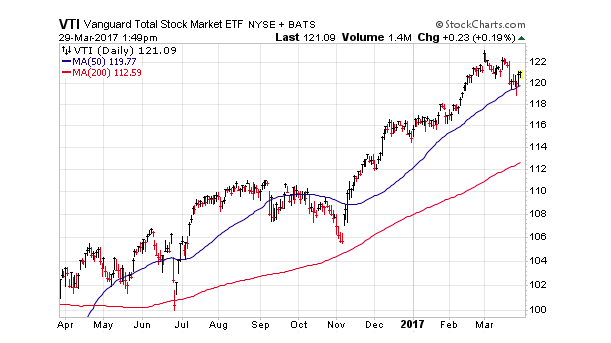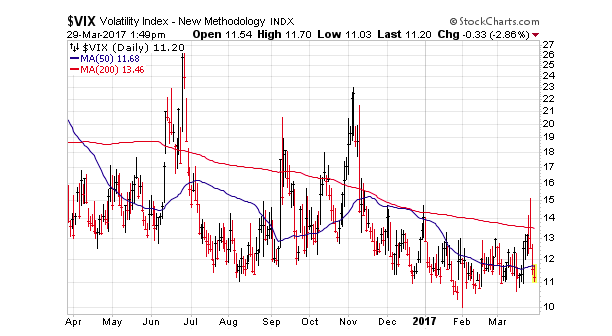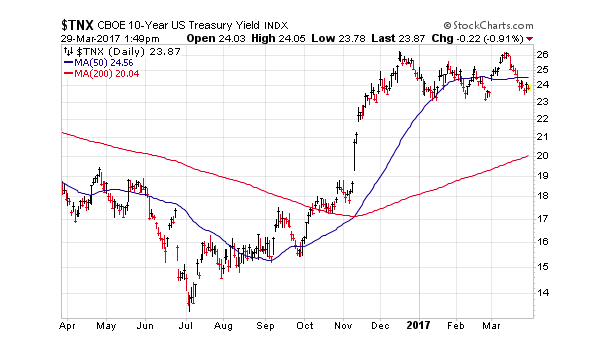Market Trends & Insights – 2Q Outlook
Forecasting the direction of the markets on a quarter by quarter basis is no easy feat. There are simply too many unknowns to determine exactly what will happen and how investors will react to future events on both a micro and macro level.
Nevertheless, a look back at recent price action and examining seasonal trends can be helpful to frame expectations. It may also elevate the need for closer examination of your existing holdings and offer consideration for changes to reduce risk or capitalize on fresh opportunities.
Perhaps the easiest place to start is the state of the equity markets as detailed by the Vanguard Total Stock Market ETF (NYSEARCA:VTI). This fund tracks virtually all 3,500 publicly traded U.S. stocks in a market-cap weighted index.
On a year-to-date basis, VTI has gained just over 5% in a solid first quarter showing. Most of that gain came in the first two months of the year, with March offering the first signs of consolidation since the 2016 election. VTI has gained nearly 12% since the election amid renewed optimism for business and consumer activity.
It’s worth noting that VTI successfully tested its 50-day moving average in March and was able to maintain its composure. This index hasn’t fallen below its 200-day moving average or truly displayed any level of meaningful volatility since the June 2016 Brexit referendum.
At this phase, the market has had time to digest the honeymoon phase of the Trump presidency alongside one of the lowest three month periods of volatility in years. That may seem like a perfect recipe for further gains on the horizon. However, I would be cautious about adding new exposure in stocks at lofty valuations without the express understanding that a correction can easily ensue.
If you follow seasonal or calendar fluctuations in the markets, you are likely aware that April marks the traditional end of the “growth season”. That will be followed by the old “sell in May and go away” saw that is predicated on weaker historical returns through the summer months. While I am not advocating selling any existing exposure at this point, it may be a prudent to exercise patience for a pullback before establishing new positions based on risk versus reward prospects.
Caution seems to be warranted by the current low readings in the CBOE VIX Volatilty Index (INDEXCBOE:VIX) as well. An extended tenure of calm in the VIX is often followed by sharp bouts of selling pressure that create new opportunities on the long side in stocks.
Turning to the bond market, the consolidation in interest rates has continued to favor a “wait and see” approach. The 10-Year Treasury Note Yield (INDEXCBOE:TNX) has been wavering between 2.3% and 2.6% since December. This sideways channel has created a definable range for those who want to trade Treasuries and hopefully given pause to the “interest rates can only go up” mantra.
I’ve continued to advocate that multi-asset portfolios hold their core bond exposure as a function of diversification and risk management. Many top ETFs in this space such as the PIMCO Total Return Bond ETF (NYSEARCA:BOND) and SPDR DoubleLine Total Return Tactical ETF (NYSEARCA:TOTL) have demonstrated far less volatility than their benchmarks over the last twelve months. In my opinion, these types of actively managed ETFs are attractive alternatives to index-based funds because of their ability to control sector positioning and interest rate risk.
The Bottom Line
It’s difficult to become overly pessimistic about a market showing this level of resilience and definable trend. Nevertheless, seasoned investors know that becoming overly enthusiastic near the highs can be fraught with peril for new holdings. Taking a more disciplined approach to seeking out pockets of value or simply waiting for a better risk/reward proposition is an attractive strategy for any additional cash on the sidelines.
Twitter: @fabiancapital
Read more on Dave’s Blog.
Any opinions expressed herein are solely those of the author, and do not in any way represent the views or opinions of any other person or entity.











